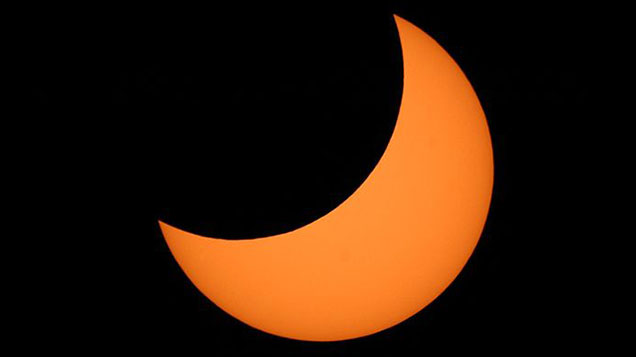EVANSTON, Ill. --- This Thursday, the sun will look more like a crescent moon during a partial solar eclipse late in the day. Northwestern University astronomers will host a free event Oct. 23 on the Evanston campus to assist the public in viewing the eclipse safely.
It is not safe to view a solar eclipse without proper eye protection. At the viewing event, faculty and students will provide a portable telescope, binoculars (with solar filters) and eclipse glasses for people to safely view the eclipse as the moon passes between Earth and the sun.
Weather permitting, the event will be held from 4:30 to 6 p.m. on the top floor of the Visitors Center Parking Garage. The eclipse will officially begin at 4:36 p.m., with the peak of the eclipse (55 percent coverage) at 5:43 p.m. That is about the time the setting sun will be lost behind the skyline. (The Dearborn Observatory will not be open during the eclipse.)
The parking garage is located at 1841 Sheridan Road. Public parking begins at 4 p.m.
“This week’s eclipse, while visible for only about an hour from Evanston, will be a nice preview of the upcoming 2017 solar eclipse -- a total eclipse for many parts of the United States,” said Michael Smutko, an associate professor of instruction in physics and astronomy at Northwestern’s Weinberg College of Arts and Sciences.
The total solar eclipse visible from parts of the continental United States will be Aug. 21, 2017. Evanston won’t see a total eclipse, but downstate Illinois will.
Smutko cautions that sunglasses, even multiple pairs, are not safe for eclipse viewing because they often transmit wavelengths of light that are invisible to the human eye but which can cause eye damage. Welder’s glass (#12 or #14) or other filters specially designed for solar viewing are required to look at the sun directly. A pinhole camera is an excellent option for people who can’t attend the viewing event or don’t have access to solar filters. (See directions below.)
The Oct. 23 eclipse-viewing event is hosted by Northwestern’s Center for Interdisciplinary Exploration and Research in Astrophysics (CIERA).
For up-to-date information, go to ciera.northwestern.edu/observatory.php.
To make a pinhole camera:
Start with two pieces of cardboard. Cut a quarter-sized hole in the center of one piece, and tape a piece of aluminum foil over that hole. Then poke a small pinhole through the piece of aluminum foil using a pin or needle. Smaller holes actually work better than larger ones. Hold this piece up to the sun so that the sun shines through the pinhole. (Do not look at the sun!) Place the second piece of cardboard behind the first so that the sunlight passing throughout the pinhole shines on the second piece of cardboard. (It helps if the second piece of cardboard is white or has white paper taped to it). You will see an enlarged image of the sun projected onto the second piece of cardboard, and it is safe to observe that image as long as you want. Several people can watch the image at the same time.
A shoebox also works well. Cut a hole in one end of the shoebox and cover it with the aluminum foil. Using a pin, poke a small hole in the foil. When lined up with the sun, an image of the sun will appear on the inside of the shoebox on the side opposite the pinhole. See how to build a shoebox pinhole camera: http://youtu.be/EGCYu7RMZLo.


